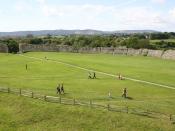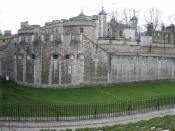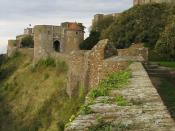When William the Conqueror took hold of England in 1066, he brought with him the culture and ideas of another people. One of the innovations imported was the stone keep. This building would dominate the English skyline for five centuries and be the cornerstone of defense for the feudal lord of the middle ages. Both the design and the evolution of the English towers and curtain-walled castles relied on defensive measures. Without the invention of new ways to defend and protect, the castle as we know it would not be standing today.
The Norman keeps of the twelfth century all employed similar structures based on fortification. Equipped keeps were needed in the Middle Ages because of the "greater efficiency of the weapons of attack which faced the defenders to protect themselves with more solid construction." Most stood on a stone plinth to support the weight of the stories above, as well as deterring attacks on the foundation.
The walls could be as many as twenty-one feet in width, and were enforced with pilasters. Each of these walls would be extended beyond the roofline, to protect the early wooden roofs. Each corner of the keeps was extended into square turrets, and could be used lookout posts as well as anchoring the walls. Access to these "Great Towers" as O'Neil called them, was a single door. Located on at least the first floor, possibly higher, entry to the keeps could only be reached by steps external to the main building and enclosed by the fore building.
Some examples of great keeps of the Norman era are the Tower of London and Dover Castle in Kent. Although a century spans the time between the births of these two structures, both have similar Norman qualities. The Tower of London is significant because the layout...


